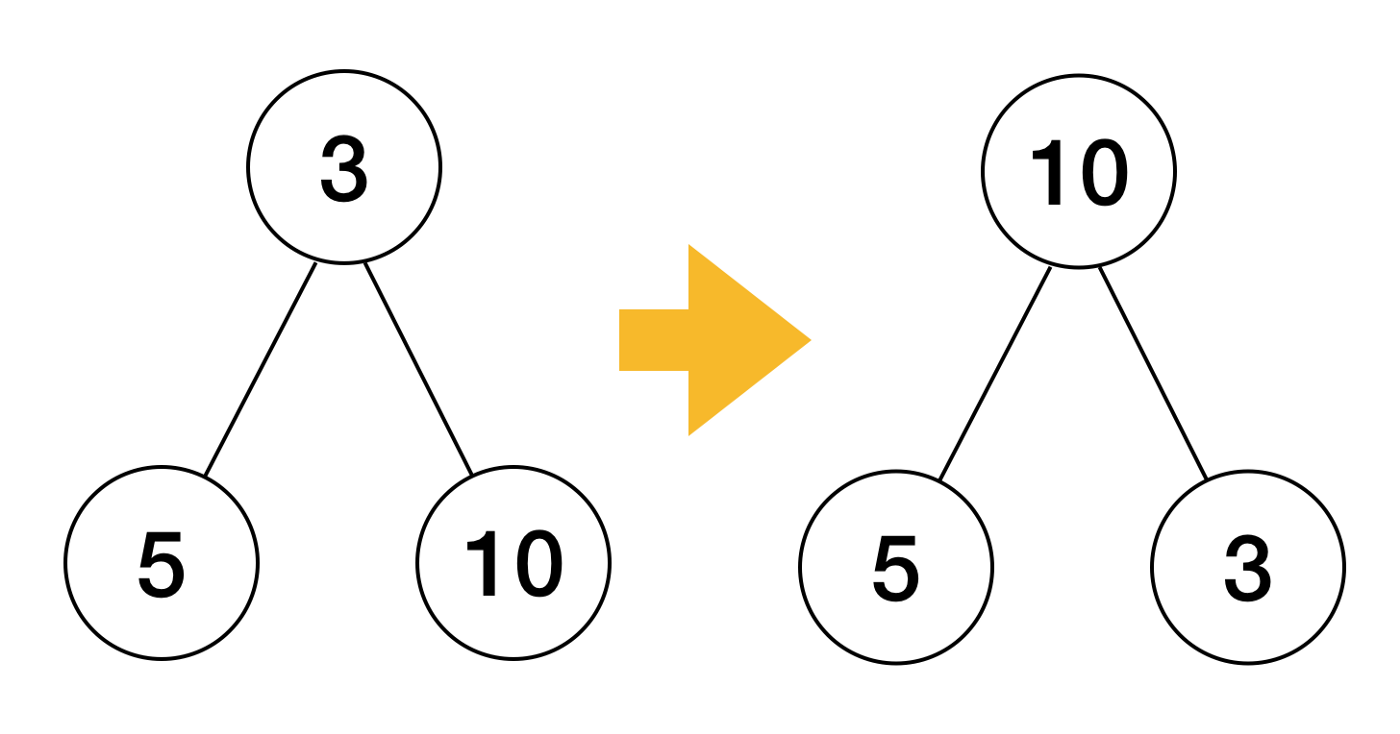18. 标准库container三剑客:head、list、ring
Heap - 堆
1. Heap - 堆
-
堆分为两种:最大堆和最小堆,两者的差别在于节点的排序方式
-
堆是一棵完全树(complete tree):即除了最底层,其他层的节点都被元素填满,且最底层尽可能地从左到右填入
-
在最大堆中,父节点的值比每一个子节点的值都要大。在最小堆中,父节点的值比每一个子节点的值都要小。这就是所谓的“堆属性”,并且这个属性对堆中的每一个节点都成立

-
而对于最小堆,根节点中的元素总是树中的最小值。堆属性非常有用,因为堆常常被当做优先队列使用,因为可以快速地访问到“最重要”的元素


-
**注意:**堆的根节点中存放的是最大或者最小元素,但是其他节点的排序顺序是未知的。例如,在一个最大堆中,最大的那一个元素总是位于 index 0 的位置,但是最小的元素则未必是最后一个元素。–唯一能够保证的是最小的元素是一个叶节点,但是不确定是哪一个
2. 堆与搜索二叉树的区别
- 堆并不能取代二叉搜索树,它们之间有相似之处也有一些不同。我们来看一下两者的主要差别:
- **节点的顺序:**在二叉搜索树中,左子节点必须比父节点小,右子节点必须必比父节点大。但是在堆中并非如此。在最大堆中两个子节点都必须比父节点小,而在最小堆中,它们都必须比父节点大。
- **内存占用:**普通树占用的内存空间比它们存储的数据要多。你必须为节点对象以及左/右子节点指针分配内存。堆仅仅使用一个数据来存储数组,且不使用指针。
- 平衡:二叉搜索树必须是“平衡”的情况下,其大部分操作的复杂度才能达到O(log n)。你可以按任意顺序位置插入/删除数据,或者使用 AVL 树或者红黑树,但是在堆中实际上不需要整棵树都是有序的。我们只需要满足堆属性即可,所以在堆中平衡不是问题。因为堆中数据的组织方式可以保证O(log n) 的性能
- **搜索:**在二叉树中搜索会很快,但是在堆中搜索会很慢。在堆中搜索不是第一优先级,因为使用堆的目的是将最大(或者最小)的节点放在最前面,从而快速的进行相关插入、删除操作
3. container/heap
-
实现接口一共有五个(
sort.Interface3个 +heap.Interface2个)1 2 3 4 5 6 7 8 9 10 11 12 13 14 15 16// sort.Interface type Interface interface { // Len is the number of elements in the collection. Len() int // Less reports whether the element with index i must sort before the element with index j. Less(i, j int) bool // Swap swaps the elements with indexes i and j. Swap(i, j int) } // heap.Interface type Interface interface { sort.Interface Push(x any) // add x as element Len() Pop() any // remove and return element Len() - 1. } -
其中heap包单独暴露了一些方法:
-
接口都需要传入上述接口的实例化对象
-
不要混淆
heap.Push和自己slice实现的Push方法- 开发者实现的
Push方法仅仅是对slice操作heap.Push调用了slice的Push操作,还需要额外的调整用以维护heap性质
- 开发者实现的
1 2 3 4 5 6 7 8 9 10// 建堆, 对heap进行初始化,生成小根堆(或大根堆) func Init(h Interface) // 插入元素 func Push(h Interface, x interface{}) // 弹出root元素 func Pop(h Interface) interface{} // Update元素(包括优先级),从i位置数据发生改变后,对堆再平衡,优先级队列的实现会使用此方法 func Fix(h Interface, i int) // 删除,从指定位置删除数据,并返回删除的数据,同时亦涉及到堆的再平衡 func Remove(h Interface, i int) interface{} -
3.1 Init
-
Init为初始化建立 heap 的方法, 该方法调用了heap.down方法 -
在
Init方法中,调整的位置,第1个的元素的位置是n/2-1个,符合最小堆的特性;最后一个位置是堆顶的位置0 -
heap.down方法的作用是,任选一个元素i,将与其子节点2i+1和2i+2比较,如果i比它的子节点小,则将i与两个子节点中较小的节点交换(代码中的j);子节点j再与它的子节点,继续比较、交换,直到数组末尾、或者待比较的元素比它的两个子节点都小,跳出当前的heap.down循环1 2 3 4 5 6 7 8 9 10 11 12 13 14 15 16 17 18 19 20 21 22 23 24 25 26 27 28 29 30 31 32 33 34 35 36 37 38 39 40 41 42// A heap must be initialized before any of the heap operations // can be used. Init is idempotent with respect to the heap invariants // and may be called whenever the heap invariants may have been invalidated. // Its complexity is O(n) where n = h.Len(). // func Init(h Interface) { // heapify n := h.Len() //堆长度,下标从0 ~ n-1 for i := n/2 - 1; i >= 0; i-- { // 从长度的一半开始,一直到第0个数据,每个位置都调用down方法,down方法实现的功能是保证从该位置往下保证形成堆 down(h, i, n) } } // 给定类型,需要调整的元素在数组中的索引以及 heap 的长度 // 将该元素下沉到该元素对应的子树合适的位置,从而满足该子树为最小堆 func down(h Interface, i0, n int) bool { i := i0 // 中间变量,初始化保存为:往下调整为heap所在的节点位置 for { j1 := 2*i + 1 // i节点的左子孩子 if j1 >= n || j1 < 0 { // j1 < 0 after int overflow // 如果j1 越界了,说明已经调整完成了,可以退出循环 break } j := j1 // left child //中间变量j先赋值为左子孩子,之后j将被赋值为左右子孩子中最小(大)的一个孩子的位置 if j2 := j1 + 1; j2 <n && h.Less(j2, j1) { j = j2 // = 2*i + 2 // right child } //j被赋值为两个孩子中的最小(大)孩子的位置(由开发者实现的Less方法决定) if !h.Less(j, i) { // 比较孩子和当前的父亲节点,如果满足堆的要求了,退出循环(注意:j在前,i在后,结果取非) break } h.Swap(i, j) // 否则交换i和j位置的值,继续比较 i = j // 保存j的位置,继续向下调整,保证j位置的子树是heap结构 } //这个结果有点意思:如果i>i0,说明调整了,返回true;否则,未调整返回false return i > i0 }
3.2 Push
-
Push方法保证插入新元素时,顺序数组h仍然是一个 heap;和上面的描述一致,将x元素插入到了数组的末尾位置,再调用up方法自下而上进行调整,使其满足 heap 的性质 -
heap.up方法也较易理解:依此(for loop)查找元素j的父节点(i),如果j比父节点i要小,则交换这两个节点,并继续向再上一级的父节点比较,直到根节点,或者元素j大于 父节点i(调整完毕,无需再继续进行)1 2 3 4 5 6 7 8 9 10 11 12 13 14 15 16 17 18 19 20 21// Push pushes the element x onto the heap. The complexity is // O(log(n)) where n = h.Len(). func Push(h Interface, x interface{}) { // 将新插入进来的节点放到最后(调用开发者封装的Push) h.Push(x) // 自下而上调整 up(h, h.Len()-1) } func up(h Interface, j int) { for { i := (j - 1) / 2 // parent(j节点的父节点) if i == j || !h.Less(j, i) { // 如果越界,或者满足堆的条件(使用开发者实现的Less方法),则结束for循环 break } // 否则将该节点和父节点交换,继续下一轮比较 h.Swap(i, j) j = i // 交换当前位置,对父节点继续进行检查直到根节点 } }
3.3 Pop
-
heap.Pop方法是取出堆顶位置的数据(minheap 为最小),取完数据之后,heap 肯定不平衡。所以通常的做法是:将根节点(0位置)与末尾节点的元素交换,并将新的根节点的元素(先前的最后一个元素)down 自上而下调整到合适的位置,满足最小堆的要求 -
最后再调用用户自定义的 Pop 函数获取最后一个元素即可; 这里需要区分 heap 包的 Pop 方法和用户自定义实现的 Pop 方法的根本区别,用户的
Pop方法只是用来获取数据的1 2 3 4 5 6 7 8 9 10// Pop removes the minimum element (according to Less) from the heap // and returns it. The complexity is O(log(n)) where n = h.Len(). // It is equivalent to Remove(h, 0). func Pop(h Interface) interface{} { // 把最后一个节点和第一个节点进行交换,之后,从根节点开始重新保证堆结构,最后把最后那个节点数据丢出并返回 n := h.Len() - 1 h.Swap(0, n) down(h, 0, n) return h.Pop() }
3.4 Remove
-
Remove方法提供了删除指定位置 index 元素的实现,即先将要删除的节点i与末尾节点n交换,然后将新的节点i下沉或上浮到合适的位置(通俗的说,由于新数据调整,原先末尾的位置升到了它不该在的位置,需要调整这个元素,先一路down到底,然后再一路up到最终的位置)1 2 3 4 5 6 7 8 9 10 11 12 13 14 15// Remove removes the element at index i from the heap. // The complexity is O(log(n)) where n = h.Len(). // func Remove(h Interface, i int) interface{} { n := h.Len() - 1 if n != i { //Pop只是Remove的特例 //Remove是把i位置的节点和最后一个节点进行交换,之后保证从i节点往下及往上都保证堆结构,最后把最后一个节点的数据返回 h.Swap(i, n) if !down(h, i, n) { up(h, i) } } return h.Pop() }
3.5 Fix
-
Fix方法的意义是在优先级队列的场景(从i位置数据发生改变后,对 heap 再平衡,优先级队列会使用本方法)。即当i节点的比较值发生改变后,需要保证heap的再平衡:先调用down保证该节点下面的堆结构,如果有位置交换,则需要保证该节点往上的堆结构,否则就不需要往上保证堆结构(没有调整影响另一侧的话,肯定是平衡的)。1 2 3 4 5 6 7 8 9// Fix re-establishes the heap ordering after the element at index i has changed its value. // Changing the value of the element at index i and then calling Fix is equivalent to, // but less expensive than, calling Remove(h, i) followed by a Push of the new value. // The complexity is O(log(n)) where n = h.Len(). func Fix(h Interface, i int) { if !down(h, i, h.Len()) { up(h, i) } }
4. 应用场景
- 定时器
- 优先级队列:比如kubernetes中的实现,FIFO-PriorityQueue
- heap排序
5. 代码示例
5.1 IntHeap
-
code
1 2 3 4 5 6 7 8 9 10 11 12 13 14 15 16 17 18 19 20 21 22 23 24 25 26 27 28 29 30 31 32 33 34 35 36 37 38 39 40 41 42 43// This example demonstrates an integer heap built using the heap interface. package heap_test import ( "container/heap" "fmt" ) // An IntHeap is a min-heap of ints. type IntHeap []int func (h IntHeap) Len() int { return len(h) } func (h IntHeap) Less(i, j int) bool { return h[i] < h[j] } func (h IntHeap) Swap(i, j int) { h[i], h[j] = h[j], h[i] } func (h *IntHeap) Push(x any) { // Push and Pop use pointer receivers because they modify the slice's length, // not just its contents. *h = append(*h, x.(int)) } func (h *IntHeap) Pop() any { old := *h n := len(old) x := old[n-1] *h = old[0 : n-1] return x } // This example inserts several ints into an IntHeap, checks the minimum, // and removes them in order of priority. func Example_intHeap() { h := &IntHeap{2, 1, 5} heap.Init(h) heap.Push(h, 3) fmt.Printf("minimum: %d\n", (*h)[0]) for h.Len() > 0 { fmt.Printf("%d ", heap.Pop(h)) } // Output: // minimum: 1 // 1 2 3 5 }
5.2 PriorityQueue 优先队列
-
code
1 2 3 4 5 6 7 8 9 10 11 12 13 14 15 16 17 18 19 20 21 22 23 24 25 26 27 28 29 30 31 32 33 34 35 36 37 38 39 40 41 42 43 44 45 46 47 48 49 50 51 52 53 54 55 56 57 58 59 60 61 62 63 64 65 66 67 68 69 70 71 72 73 74 75 76 77 78 79 80 81 82 83 84 85 86 87 88 89 90 91 92 93 94// This example demonstrates a priority queue built using the heap interface. package heap_test import ( "container/heap" "fmt" ) // An Item is something we manage in a priority queue. type Item struct { value string // The value of the item; arbitrary. priority int // The priority of the item in the queue. // The index is needed by update and is maintained by the heap.Interface methods. index int // The index of the item in the heap. } // A PriorityQueue implements heap.Interface and holds Items. type PriorityQueue []*Item func (pq PriorityQueue) Len() int { return len(pq) } func (pq PriorityQueue) Less(i, j int) bool { // We want Pop to give us the highest, not lowest, priority so we use greater than here. return pq[i].priority > pq[j].priority } func (pq PriorityQueue) Swap(i, j int) { pq[i], pq[j] = pq[j], pq[i] pq[i].index = i pq[j].index = j } func (pq *PriorityQueue) Push(x any) { n := len(*pq) item := x.(*Item) item.index = n *pq = append(*pq, item) } func (pq *PriorityQueue) Pop() any { old := *pq n := len(old) item := old[n-1] old[n-1] = nil // avoid memory leak item.index = -1 // for safety *pq = old[0 : n-1] return item } // update modifies the priority and value of an Item in the queue. func (pq *PriorityQueue) update(item *Item, value string, priority int) { item.value = value item.priority = priority heap.Fix(pq, item.index) } // This example creates a PriorityQueue with some items, adds and manipulates an item, // and then removes the items in priority order. func Example_priorityQueue() { // Some items and their priorities. items := map[string]int{ "banana": 3, "apple": 2, "pear": 4, } // Create a priority queue, put the items in it, and // establish the priority queue (heap) invariants. pq := make(PriorityQueue, len(items)) i := 0 for value, priority := range items { pq[i] = &Item{ value: value, priority: priority, index: i, } i++ } heap.Init(&pq) // Insert a new item and then modify its priority. item := &Item{ value: "orange", priority: 1, } heap.Push(&pq, item) pq.update(item, item.value, 5) // Take the items out; they arrive in decreasing priority order. for pq.Len() > 0 { item := heap.Pop(&pq).(*Item) fmt.Printf("%.2d:%s ", item.priority, item.value) } // Output: // 05:orange 04:pear 03:banana 02:apple }
List - 双向链表
0. 结构
|
|
1. 代码示例
-
code
1 2 3 4 5 6 7 8 9 10 11 12 13 14 15 16 17 18 19func Example() { // Create a new list and put some numbers in it. l := list.New() e4 := l.PushBack(4) e1 := l.PushFront(1) l.InsertBefore(3, e4) l.InsertAfter(2, e1) // Iterate through list and print its contents. for e := l.Front(); e != nil; e = e.Next() { fmt.Println(e.Value) } // Output: // 1 // 2 // 3 // 4 }
2. Element的方法
|
|
3. List的方法
|
|
4. 应用场景
5. 注意问题与坑
5.1 注意问题
- 不要使用自己构造的Element结构,作为参数传入List的方法
Remove方法是传入指定位置的元素(list的Remove实现),复杂度是O(1),需要开发者保存对应的element的指针(地址)- 若在goroutine并发环境下使用
container/list链表,那么需要加锁 - List并未提供
Pop类方法,需要自行组合实现,不过需要加锁 - List包中大部分对于
e *Element进行操作的元素都可能会导致程序崩溃,其根本原因是e是一个Element类型的指针,当然其也可能为nil,但是go中list包中函数没有对其进行是否为nil的检查,变默认其非nil进行操作,所以这种情况下,便可能出现程序崩溃
5.2 坑
-
遍历删除List中的所有元素, 遍历删除不安全
-
问题code:注意到返回被删除的
Element时,会将e.next = nil1 2 3 4 5 6 7 8 9 10 11 12 13 14 15 16 17 18func main() { l := list.New() l.PushBack(1) l.PushBack(2) l.PushBack(3) l.PushBack(4) // 遍历list,删除元素 for e := l.Front(); e != nil; e = e.Next() { fmt.Println("removing", e.Value) l.Remove(e) } fmt.Println("After Removing...") // 遍历删除完元素后的list for e := l.Front(); e != nil; e = e.Next() { fmt.Println(e.Value) } }
-
-
List大部分方法不检查传入参数为
nil -
并发不安全
Ring - 环形链表
0. 结构
|
|
1. 代码示例
-
code
1 2 3 4 5 6 7 8 9 10 11 12 13 14 15 16 17 18 19 20func main() { // 创建一个环, 包含 3 个元素 r := ring.New(3) fmt.Printf("ring: %+v\n", *r) // 初始化 for i := 1; i <= 3; i++ { r.Value = i r = r.Next() } fmt.Printf("init ring: %+v\n", *r) // sum s := 0 r.Do(func(i interface{}) { fmt.Println(i) s += i.(int) }) fmt.Printf("sum ring: %d\n", s) }
2. Ring 方法
|
|
3. 应用场景
- 构造定长环回队列,如保存固定长度的数据等
- 用作固定长度的对象缓冲区(参见goim的数据结构分析)
4. ring 和 list的区别
- Ring 类型的数据结构仅由它自身即可代表,而 List 类型则需要由它以及 Element 类型联合表示
- 一个 Ring 类型的值严格来讲,只代表了其所属的循环链表中的一个元素,而一个 List 类型的值则代表了一个完整的链表
- 在创建并初始化一个 Ring 时,可以指定它包含的元素数量,但是对于一个 List 值来说却不需要。循环链表一旦被创建,其长度是不可变的
- 通过
var r ring.Ring声明的r将会是一个长度为1的循环链表,而 List 类型的零值则是一个长度为0的链表。)(List 中的根元素不会持有实际元素的值) - Ring 的
Len方法的算法复杂度是O(N),而 List 的Len算法复杂度是O(1)
 支付宝
支付宝
 微信
微信
